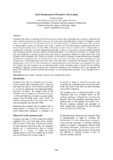Stock Enhancement of Portunid Crabs in Japan
นามธรรม
Portunid crabs such as swimming crab Portunus trituberculatus, blue swimming crab P. pelagicus and mud crab species Scylla paramamosain and S. serrata are one of the most important fishery resources in Japanese coastal waters. The annual catch of the Portunid crabs have fluctuated between arrow up ,300 and 5,600 tons in Japan. In order to sustain and/or increase the Portunid crabs stock, a number of 30 million hatchery-produced juveniles have been released annually since the late 1980s. Estimating recapture rates of stocked crabs is indispensable to evaluate the effectiveness of stock enhancement programs, so that it is necessary to develop marking methods that distinguish between wild and hatchery-released individuals. The stocking effectiveness of Portunid crabs have been difficult to estimate because there have been no appropriate methods to mark small body sized juveniles which frequently molt. Therefore, recently, we developed a technique to mark juveniles and eventually estimated the contribution rates of released crabs to the total catch of the mud crab and swimming crab. The mixture rate of released juveniles in the total catch of the mud crab is estimated by the method of genetic stock identification, to be 5-19.7%. The contribution of released juveniles to the total catch was estimated to be about 0.5-1 metric ton. The recapture rate of released juveniles of the swimming crab is estimated by the marking technique of clipping swimming leg dactylus. Estimated contribution rate of marked crabs to the landings was about 3.0%. Effective marking methods and potential of stock enhancement programs for the Portunid crabs is discussed.
การอ้างอิง
Obata, Y. (2016). Stock enhancement of Portunid crabs in Japan. In H. Kawamura, T. Iwata, Y. Theparoonrat, N. Manajit, & V. T. Sulit (Eds.), Consolidating the Strategies for Fishery Resources Enhancement in Southeast Asia. Proceedings of the Symposium on Strategy for Fisheries Resources Enhancement in the Southeast Asian Region, Pattaya, Thailand, 27-30 July 2015 (pp. 157–-60). Samutprakan, Thailand: Training Department, Southeast Asian Fisheries Development Center.

